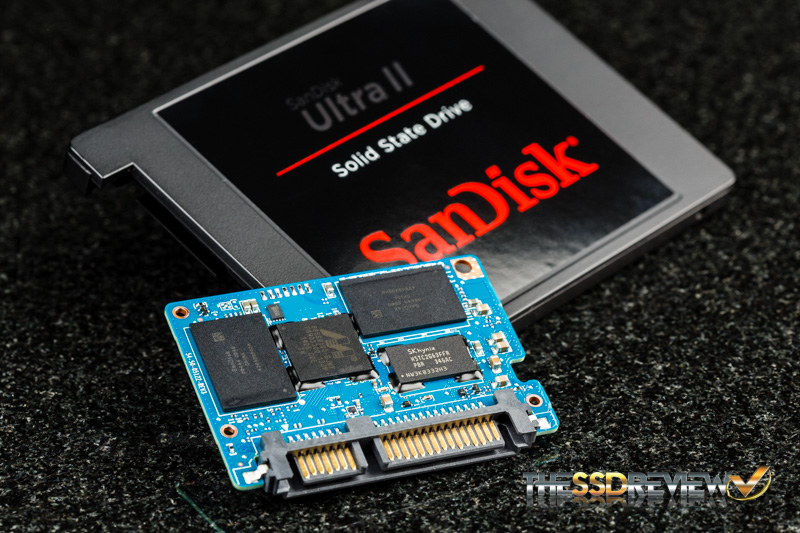Today we have the SanDisk Ultra II that was released 9 months ago. Similar to the last SSD of the Week, we have another SSD with amazing dollar per GB value at $0.34/GB. The Ultra II has equivalent rated sequential speeds across all capacities using SanDisk’s new TLC NAND. With recent price drops from competitors SanDisk has lowered their SSDs to similar prices resulting in extremely good deals for you, the consumer.
The SanDisk Ultra II comes in a 2.5 inch 7mm form factor and is available in the 120GB ($69.54), 240GB ($89.99), 480GB ($169.99), and 960GB ($329.99) capacities. The Ultra II is rated for sequential speeds up to 550 MB/s read and 500 MB/s write. The 4K performance is rated up to 99K read IOPS and 83K write IOPS. Also, as standard with most SSDs these days the Ultra II comes with S.M.A.R.T., TRIM, and NCQ.
Beside the basic features the SanDisk Ultra II has numerous advanced flash management features including nCache 2.0, multi-page recovery, XOR recovery, dynamic and static wear-leveling, bad block management, and background garbage collection. Due to the disadvantages of TLC such as slower speeds, lower program/erase cycles, and data integrity errors, SanDisk has equipped the Ultra II with the nCache 2.0 technology and Multi Page Recovery. SanDisk’s nCache 2.0 technology utilizes a two-tiered caching architecture to optimize speed and endurance. Also, Cache 2.0 is a non-volatile write cache feature that essentially makes a portion of the TLC NAND to function as SLC NAND to increase the drives performance. In addition to this really neat technology, SanDisk also offer the SanDisk SSD Dashboard Software. This software allows you to monitor the performance, manual or scheduled TRIM, available firmware updates and tips on how to maintain the drive at its peak operation. Other software features include cloning by Apricorn, Trend Micro™ Titanium™ Antivirus+, and Absolute Lojack, a security by Absolute Software.
Overall, the Ultra II is a really good value mainstream SSD with a boatload of cool features. Therefore, if you are looking for a quality SSD at an entry level price point check out the SanDisk Ultra II.
In our review of the Ultra II it received our top value award for its low price point. This should show you how great a value this SSD is at this time.
 The SSD Review The Worlds Dedicated SSD Education and Review Resource |
The SSD Review The Worlds Dedicated SSD Education and Review Resource | 


Due to the disadvantages of TLC such as slower speeds, lower program/erase cycles, and data integrity errors, SanDisk has equipped the Ultra II with the nCache 2.0 technology and Multi Page Recovery. Therefore, if you are looking for a quality SSD at an entry level price point check out the SanDisk Ultra II. I thought these two statements would be funny if put together.
Yeah, but ncache does help with endurance, as its pretty much SLC. And SLC is much better at endurance and write speeds.
If SLC is better than MLC which is better than TLC, why use mostly TLC with some SLC for a boost? Why not just use MLC from the start? It seems like the write speeds of ssds are going in the wrong direction for entry level ssds. But everyone one is saying the average consumer won’t know the difference, but I’m not sure if that’s true. Because if you copy or backup large files there has to be a difference in the time it takes and most consumers are going to copy or backup large files eventually if not regularly. Why make any ssds that can only move large files close to hard drive speeds sata 1 100mbs when we have sata 3 at > 500mbs. The ssds start fast but slow down as soon as SLC or cache is used up we need nand that can stay around 500 all the time at an affordable price.
>Why not just use MLC from the start?
Because TLC is cheaper, as you can cram 50% more bits into a given cell.
> But everyone one is saying the average consumer won’t know the difference, but I’m not sure if that’s true.
It is.
>Because if you copy or backup large files there has to be a difference in the time it takes and most consumers are going to copy or backup large files eventually if not regularly.
How many consumers actually make backups or move large files around when streaming is the thing ?
>Why make any ssds that can only move large files close to hard drive speeds sata 1 100mbs when we have sata 3 at > 500mbs.
Because ssds are soo much more than just sequential speeds. Actually, sequential speeds matter very little, its the random speeds and access times, that blow hdds out of the water.
>The ssds start fast but slow down as soon as SLC or cache is used up we need nand that can stay around 500 all the time at an affordable price.
Most cosumer workloads are exactly that; smallish and in bursts.
And besides, most of the workload is reads and pretty much every ssds can hit 500MB/s, even tlc ones (without the help of slc).
Thanks for the clarification. I Think you answered everything. I have one more question. If random speed and access time are the most important features of an ssd and sequential speeds matter very little, then does it matter if you use sata 2, sata 3, or even pcie for consumers? They should probably see no difference, no need to upgrade.
There very little difference between interfaces. Atleast on normal workloads anyway.